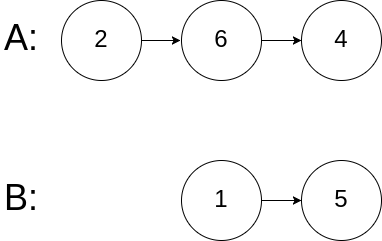LeetCode--LinkedList--160. Intersection of Two Linked Lists(Easy)
160. Intersection of Two Linked Lists(Easy)
题目地址https://leetcode.com/problems/intersection-of-two-linked-lists/
Write a program to find the node at which the intersection of two singly linked lists begins.
For example, the following two linked lists:

begin to intersect at node c1.
Example 1:

Input: intersectVal = 8, listA = [4,1,8,4,5], listB = [5,0,1,8,4,5], skipA = 2, skipB = 3
Output: Reference of the node with value = 8
Input Explanation: The intersected node's value is 8 (note that this must not be 0 if the two lists intersect). From the head of A, it reads as [4,1,8,4,5]. From the head of B, it reads as [5,0,1,8,4,5]. There are 2 nodes before the intersected node in A; There are 3 nodes before the intersected node in B.
Example 2:

Input: intersectVal = 2, listA = [0,9,1,2,4], listB = [3,2,4], skipA = 3, skipB = 1
Output: Reference of the node with value = 2
Input Explanation: The intersected node's value is 2 (note that this must not be 0 if the two lists intersect). From the head of A, it reads as [0,9,1,2,4]. From the head of B, it reads as [3,2,4]. There are 3 nodes before the intersected node in A; There are 1 node before the intersected node in B.
Example 3:

Input: intersectVal = 0, listA = [2,6,4], listB = [1,5], skipA = 3, skipB = 2
Output: null
Input Explanation: From the head of A, it reads as [2,6,4]. From the head of B, it reads as [1,5]. Since the two lists do not intersect, intersectVal must be 0, while skipA and skipB can be arbitrary values.
Explanation: The two lists do not intersect, so return null.
Notes:
- If the two linked lists have no intersection at all, return null.
- The linked lists must retain their original structure after the function returns.
- You may assume there are no cycles anywhere in the entire linked structure.
Your code should preferably run in O(n) time and use only O(1) memory.
solution
题意是给定两个链表头headA与headB,判断两个链表是否有交叉的部分,若有,则返回交叉部分的起点结点,否则,返回null。
解法一
/**
* Definition for singly-linked list.
* public class ListNode {
* int val;
* ListNode next;
* ListNode(int x) {
* val = x;
* next = null;
* }
* }
*/
public class Solution {
public ListNode getIntersectionNode(ListNode headA, ListNode headB) {
ListNode p = headA, q = headB;
while (p != q) //如果两指针重合
{
p = (p != null) ? p.next : headB;
q = (q != null) ? q.next : headA;
}
return p;
}
}
解析:解法一的思路很巧妙,代码量也很少。虽然题目中强调了链表中不存在环,但是我们可以用环的思想来做,我们让两条链表分别从各自的开头开始往后遍历,当其中一条遍历到末尾时,我们跳到另一个条链表的开头继续遍历。两个指针最终会相等,而且只有两种情况。若headA的长度大于headB,则当遍历完headA时,headA的遍历指针p指向headB,当遍历完headB时,headB的遍历指针q指向headA,此时,p与q刚好指向headA与headB右对齐后的同一位置,即headA的头结点处。随后只需继续同时遍历两个链表,并比较对应位置的结点是否交叉。
解法二
public class Solution {
public ListNode getIntersectionNode(ListNode headA, ListNode headB) {
ListNode p = headA, q = headB;
int alength = 0,blength = 0;
while (p != null)
{
alength++;
p = p.next;
}
while (q != null)
{
blength++;
q = q.next;
}
p = headA; q = headB; int i = 0, start = 0;
if (alength > blength)
{
start = alength - blength;
while (p != null && i < start)
{
p = p.next;
i++;
}
}
else
{
start = blength - alength;
while (q != null && i < start)
{
q = q.next;
i++;
}
}
while (p != null && q != null && p != q)
{
p = p.next;
q = q.next;
}
return p;
}
}
解析:解法二思路很直接,代码量也多点。如果两个链长度相同的话,那么对应的一个个比下去就能找到,否则只需要把长链表变短再挨个比较即可。具体做法为:分别遍历两个链表,得到其对应的长度。然后求长度的差值,把较长的那个链表向后移动这个差值的个数,然后一一比较即可。
reference
https://www.cnblogs.com/grandyang/p/4128461.html
Notes
1.链表问题思路较多,注意不同思路的差异;
点个推荐再走吧


